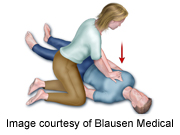- Navigating Your Midlife Crisis: Embracing New Possibilities
- City Raccoons Showing Signs of Domestication
- Mapping the Exposome: Science Broadens Focus to Environmental Disease Triggers
- One Week Less on Social Media Linked to Better Mental Health
- Your Brain Changes in Stages as You Age, Study Finds
- Some Suicide Victims Show No Typical Warning Signs, Study Finds
- ByHeart Formula Faces Lawsuits After Babies Sickened With Botulism
- Switch to Vegan Diet Could Cut Your Greenhouse Gas Emissions in Half
- Regular Bedtime Does Wonders for Blood Pressure
- Dining Alone Could Mean Worse Nutrition for Seniors
CPR Phone Guidance Boosts Cardiac Arrest Survival, Study Says


Talking bystanders through CPR methods for a cardiac emergency during a 911 call can significantly boost survival rates, a new study suggests.
State researchers in Arizona examined the aggressive use of so-called pre-arrival telephone CPR guidelines — step-by-step dispatcher instructions on administering cardiopulmonary resuscitation before trained rescuers arrive — and found that it bumped survival of cardiac arrest patients from about 8 percent to more than 11 percent.
Cardiac arrest occurs when the heart’s normal rhythm abruptly stops, and the organ can no longer pump blood and oxygen to the body. It can be triggered by a heart attack, but the two conditions are different.
Lead researcher Dr. Ben Bobrow said the type of focused intervention studied in his home state — not only training telephone dispatchers but measuring bystander CPR outcomes and circling back to 911 centers with feedback — is not done uniformly on a national basis, despite American Heart Association (AHA) guidelines.
But he hopes the results of his study, scheduled to be presented Saturday at the AHA meeting in Chicago, will promote that ideal.
“We believe strongly that this may be the best, and most efficient, way to improve survival rates across the country,” said Bobrow, the medical director of the Bureau of EMS and Trauma System for the Arizona Department of Health Services. “Cardiac arrest is one of the leading causes of death, and as a country, despite tons of efforts … this has not improved.”
About 359,000 people in the United States suffered sudden cardiac arrest outside of a hospital setting in 2013, and more than 90 percent of them died, according to the AHA.
The heart association also has reported that 70 percent of Americans feel helpless to act during a cardiac arrest emergency because they don’t know CPR or their training had lapsed.
Bobrow and his colleagues analyzed more than 4,000 audio recordings from 911 calls over three years from eight Arizona dispatch centers. That information, paired with emergency medical services (EMS) and hospital outcome data, showed that providing telephone CPR instructions prompted a jump in the number of bystanders implementing CPR, from 44 percent to 62 percent.
With the guidelines in place, the average amount of time elapsing between a bystander’s call to 911 and the first chest compression in CPR dropped by 23 seconds, to 155 seconds.
“This research shows . . . that even the simplest of interventions, like having someone on the other end of a phone guide you [in CPR], can result in a remarkable difference of outcome,” said Dr. Vinay Nadkarni, a spokesperson for the AHA, who wasn’t involved in the study.
“That change is possible with a cellphone and our own two hands,” added Nadkarni, an associate professor of anesthesiology and critical care at the University of Pennsylvania School of Medicine. “It’s within our grasp.”
Nadkarni said that Bobrow and his team had done an “excellent job” in helping 911 dispatchers in Arizona use certain phrases to prompt quick action among bystanders who witness a cardiac arrest.
For example, before the intervention, dispatchers typically asked 911 callers if anyone was available to perform CPR, or if they would be willing to. After the Web-based and live training, the revised script emphasized the importance of dispatchers directing callers to start CPR, saying something like, “You need to do chest compressions and I’m going to help you. Let’s start.”
With the apparent success of this approach, Bobrow said he and his team have asked the U.S. Centers for Disease Control and Prevention to consider implementing it on a national scale. Funding for such a program is needed, he said.
“It would be an incredibly inexpensive intervention for how many lives it would save,” he said. “We estimate conservatively that it would save several thousand lives per year. It’s not complicated stuff . . . and the beauty of the 911 system is that it already exists.”
Research presented at scientific conferences typically has not been peer-reviewed or published and results are considered preliminary.
More information
The American Heart Association offers information and videos on hands-only CPR.
Source: HealthDay
Copyright © 2025 HealthDay. All rights reserved.










